Deutsche Mark
![]()
This article deals with the former currency of the Federal Republic of Germany. For the currency of the same name of the German Democratic Republic from 1948 to 1964, see Mark (DDR).
The Deutsche Mark (abbreviated DM and in international banking DEM, colloquially also D-Mark or Mark for short, in English-speaking countries usually Deutschmark) was the official currency in the Federal Republic of Germany from 1948 to 1998 as book money, until 2001 only as cash, and before its foundation in the three western occupation zones of Germany and the western sectors of Berlin. One Deutsche Mark was divided into one hundred pfennigs. The currency was issued in coins and notes. There were four series of banknotes.
The Deutsche Mark was introduced as legal tender on 21 June 1948 in the trizone and three days later in the three western sectors of Berlin by the currency reform of 1948, replacing the Reichsmark as the legal currency unit. Even after the founding of the Federal Republic of Germany on 23 May 1949, the Deutsche Mark remained the monetary unit in the Federal Republic including West Berlin.
When monetary, economic and social union came into force on 1 July 1990, it replaced the mark of the GDR. The Deutsche Mark remained legal tender in the reunified Germany. Following the establishment of the European Economic and Monetary Union, the Deutsche Mark was finally replaced by the euro as book money on 1 January 1999 and as cash on 1 January 2002.
According to the Deutsche Bundesbank, DM banknotes with a nominal value of DM 5.78 billion and coins with a value of DM 6.61 billion (total: DM 12.39 billion) had not yet been exchanged on 30 April 2021. This was 5.1% of the DM 244.8 billion in circulation in 2000.

1-DM-bill of the first issue 1948Front and back side
Naming
The designation "Deutsche Mark" for the new currency of the Trizone was based on the traditional German currency unit, the mark. It was unanimously accepted at conferences of the occupying powers at the suggestion of American officer Edward A. Tenenbaum, who served as assistant financial advisor to military governor Lucius D. Clay, it was unanimously accepted at conferences of the occupying powers. Tenenbaum, who came from a Polish-Jewish family and had earned his doctorate at Yale in 1942 with a dissertation on National Socialism and international capitalism, was also one of the leading theoretical minds and preparers of the currency reform of 1948. His importance as the "father of the D-Mark" is hardly known to the German public and was only appreciated relatively late in the historical sciences, for example by Wolfgang Benz, Hans-Ulrich Wehler and Werner Abelshauser.
Cash
→ Main article: Deutsche Mark cash
Coins
From 1948 to 1950, the Bank deutscher Länder held the right to issue coins. The first DM coins therefore bore the inscription "BANK DEUTSCHER LÄNDER". The law on the minting of coins of 8 July 1950 transferred this right to the Federal Government. Since then, all DM coins have been minted with the inscription "BUNDESREPUBLIK DEUTSCHLAND".
The coins were produced according to a fixed minting key in the four existing mints of the Federal Republic: Hamburg (mintmark J), Karlsruhe (G), Munich (D) and Stuttgart (F). Shortly before the introduction of monetary union on 1 July 1990, D-Mark coins also began to be minted in Berlin (mintmark A). Previously, the coins for the mark of the GDR had been minted there.
The appearance of the coins remained largely unchanged during the 53 years in which the D-Mark was issued. Initially there were coins of 1, 2, 5 and 10 pfennigs, which consisted of a steel core and were only thinly plated with copper or brass, as well as coins made of a copper-nickel alloy of 50 pfennigs, 1 and 2 D-marks. The 2 pfennig coin was made of a 95 percent copper alloy until 1967. The 5-DM coin was initially made of a silver-copper alloy.
Because of frequent confusion with the 1-DM coin, the 2-DM piece was replaced in 1958 by a slightly larger coin with the portrait of Max Planck. Since vending machines had difficulty distinguishing this coin from some foreign coins, especially those of lower denomination, the 2-DM piece was replaced again in the 1970s and the "politician series" made of the three-layer material Magnimat, which was valid until the end of the D-Mark, was introduced.
On the occasion of the organisation of the 1972 Summer Olympic Games and from 1987 onwards, 10-D-Mark commemorative coins were issued.
The motif and the material of the 5-DM coin were also changed in 1975. Because the price of silver had risen so much that the material value of the coin threatened to exceed the face value, the 5-mark coin was now also made of Magnimat.
All DM coins have now been "called up", i.e. they have been withdrawn from circulation, but they will continue to be exchanged for euros by the Bundesbank (with the exception of the 2 DM coin of the first issue).
Banknotes
There were four officially issued series of banknotes. In addition, the existence of two replacement series is known, which were stored in the Bundesbank bunker in Cochem, but were never put into circulation. In addition, there were Bundeskassenscheine, a substitute banknote series that was supposed to replace coins in times of crisis, but was also never issued.
The banknotes of the first series (about six billion marks) were printed in the USA and transported to Germany via Bremerhaven in the top-secret operation "Bird Dog". The banknotes did not yet bear the name of the issuing bank and contained no information about the place of issue or the exact date of issue. These banknotes, visually strongly reminiscent of the US dollar, were then issued with the currency reform on 20 June 1948 by the Bank deutscher Länder under the sovereignty of the Western Allies. Four days later, the Deutsche Mark was introduced in the western sectors of Berlin, but these banknotes were marked with a "B" stamp and/or perforation. The denominations of this series were ½, 1, 2, 5, 10, 20, 50 and 100 marks, with two different designs for the 20 and 50 mark banknotes. Since there was still a shortage of coins, certain Reichsmark coins could be temporarily reused at one-tenth of their face value.
The second series now had the name of the issuing bank "Bank deutscher Länder" printed on it. It gradually replaced the first issue. In addition, three banknote denominations were designed by Max Bittrof, with head portraits or figures from mythology dominating the banknote. This series consisted of the denominations 5 and 10 Pfennig as well as 5, 10, 20, 50 and 100 Mark.
The third series of banknotes was issued from 1961 until the early 1990s and was withdrawn from circulation on 30 June 1995. Plans for the new banknote series had already been made in 1957 when the Bank deutscher Länder was transformed into the Deutsche Bundesbank, as the indication "Bank deutscher Länder" printed on the previous series was now no longer correct. As the first series issued by the Bundesbank, it bears the internal designation "BBk I". The Swiss designer Hermann Eidenbenz emerged as the winner of a design competition, but the head likenesses, inscriptions and format of the banknotes had been specified in advance by the Bundesbank. This series included the nominals 5, 10, 20, 50 and 100 Mark. In addition, the values 500 and 1000 Mark were newly introduced.
In 1981, the Central Bank Council of the Deutsche Bundesbank decided to issue a new series of banknotes. It had become necessary due to technical progress, which made it increasingly easy to counterfeit the old banknotes. The new series was to be more suitable for automatic payment transactions. Almost ten years later, on 1 October 1990, the first two banknote denominations of the series designed by Reinhold Gerstetter were put into circulation, which was extended to eight denominations by the new DM 200 note. The banknotes bore the internal designation "BBk III", since "BBk II" had already been used for the replacement series mentioned above.
In 1997 and 1998, the 50, 100 and 200 mark banknotes were issued with revised security features, as they were the most frequently counterfeited. The most striking changes here are the kinegram on the left-hand side and the pearlescent stripe on the right-hand side of the front. These banknotes were given the internal series designation "BBk IIIa".
· The 100 notes through the ages
· 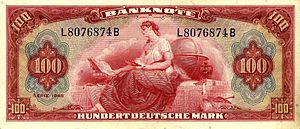
First series (1948-1956)
designed and printed in the USA
· 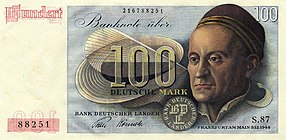
Second series (1951-1965)
The Nuremberg councillor Jakob Muffel
· 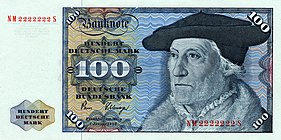
Third series "BBk I" (1961-1995)
Cosmographer Sebastian Münster
· 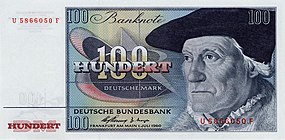
Replacement series "BBk II" for West Germany
never came into
circulation
· 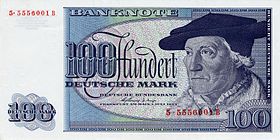
Replacement series "BBk IIa" for West-Berlinkam
never in circulation
· 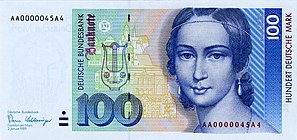
Fourth series "BBk III" (1990-2001)
Composer and pianist Clara Schumann
· 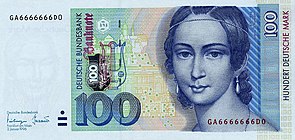
Fourth series "BBk IIIa" (1997-2001)
with kinegram as new security feature
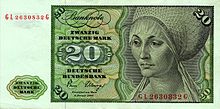
This version of the twenty-mark note was the banknote that remained in circulation unchanged the longest. It was first issued as the first banknote of the third series on 10 February 1961, and it was only after 11,371 days (over 31 years) that the successor note was put into circulation.
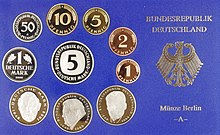
Front sides of the German Mark coins from the year 2000, with the 2-DM coins Ludwig Erhard, Franz Josef Strauß and Willy Brandt
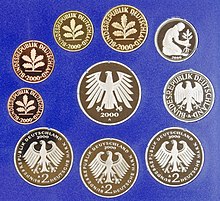
Backs of the coins
Search within the encyclopedia